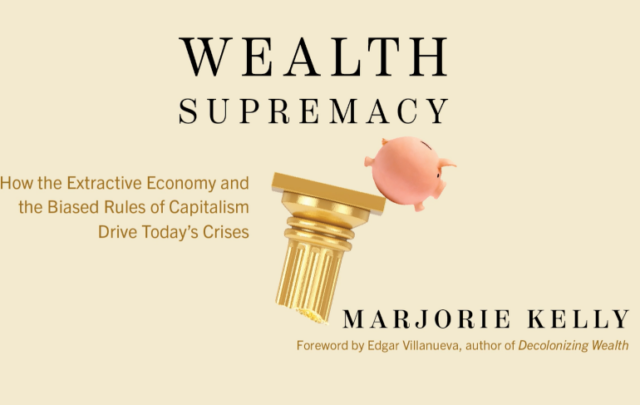For former Wall Street hedge fund manager and self-styled student of uncertainty Nassim Nicholas Taleb an important cause of the current financial meltdown is best described by ecological science. The system has become overoptimized. The consolidation of finance into the hands of fewer and fewer large players–banks, insurance companies, investment banks, and giant hedge funds–has made it less vulnerable to frequent crises, but more likely to produce a severe crisis when there is a breakdown in the system.
What used to be country-specific or regional crises, now become worldwide crises. In the past we’ve had the Mexican crisis, the Asian crisis, the Argentinian meltdown and most recently the utterly devastating hyperinflation in Zimbabwe. But none of these became global crises.
“It’s vastly more optimal to have one large bank than 10 small banks. It’s more efficient,” Taleb told The News Hour with Jim Lehrer recently. “[But,] when one bank, [a] large bank makes a mistake, OK, it’s 10 times worse than a small bank making a mistake.” The moral of the story: A world with a lot of small banks is far more resilient than one with a few large banks. That’s the kind of result one would expect in biological communities, and it turns out to be true, not surprisingly, in human communities as well.
But overoptimization isn’t just limited to the banking industry. In fact, it is everywhere, and it makes for vulnerabilities across multiple fronts that quite often interact with one another. We’ve built a system too complex for any human to understand. Therefore, when something major goes wrong, no one can be sure how to correct it.
Witness the floundering attempts to revive the comatose credit markets. The seemingly incoherent policy shifts exhibited by U. S. Treasury Secretary Henry Paulson and Federal Reserve Chairman Ben Bernanke are not so much a result of incompetence as a reaction to the opacity of the global economy and the inability of anyone to grasp its workings or interpret its supposed signals.
As for the vulnerabilities across multiple fronts, one need look no further than the world’s ports. The financial crisis has slowed many to a crawl as exporters worry that importers on the other side of the ocean may not be able to pay them. Banks are reluctant to issue letters of credit guaranteeing payments when they can’t be sure the bank on the other side of the transaction is sound. This has driven dry cargo rates down 90 percent from their highs this year forcing some shipping companies to simply idle freighters. In addition, several shipping companies are on the verge of bankruptcy. And, that means orders for new ships are plummeting as well driving shipbuilders toward bankruptcy or at least consolidation.
The tight coupling and vast size of the globe’s major economic actors, once hailed a triumph for economic efficiency, has now become an Achilles’ heel. Only a few months ago the globe’s just-in-time delivery system was strained beyond the limit. Now, as demand has fallen off a cliff, it’s spewing out so much stuff that the Port of Long Beach doesn’t know where to put all the imported cars coming ashore. Feast or famine, the system wasn’t designed for surges or sudden drops in demand.
Overoptimization has taken place in agriculture as well. We are now hostage to such potential crises as the so far unstoppable wheat rust which threatens to knock down wheat yields worldwide. Farms that grow and rotate multiple crops with multiple varieties would be less efficient, but far more resilient in the face of such plant diseases.
And, with the huge, but clunky U. S.-Canadian electrical grid, we are subject to large consequences from small disturbances. Overgrown tree limbs in Ohio were said to blame for the 2003 power outage that deprived 50 million people of electricity from Detroit to New York and from the Ohio River to northern Ontario. A distributed power system made up of a large number of individual home and business generators might be less efficient; but it would be much more resilient. A failure of even many parts of such a power system would leave most of the rest functioning.
The effects of the overoptimized society have been seen in price swings as well. Small changes in the supply and demand for oil can send the price soaring or plunging, and we have seen both this year. The same has been true in the grain and base metals markets.
What all this tell us is that the pablum we’ve been fed about the merits of globalization has masked its dreadful vulnerabilities. We have created a system that nobody understands and nobody can fix when it falters. We were told that the global marketplace could heal itself and correct imbalances. Well, obviously it can’t, not without mowing down an awful lot of people who did nothing to cause the current financial meltdown.
That’s the problem with a complex, tightly interconnected network. When it spirals out of control, it tends to create a cascade of problems everywhere. Nassim Taleb says he used to get up in the morning and worry about what will happen to our out-of-control financial system. Now, he wakes up in the middle of the night and wonders how bad it could get.
Maybe, just maybe, it’s time to redesign our society with resilience in mind. If things keep going in the current direction, we will surely be forced to.






